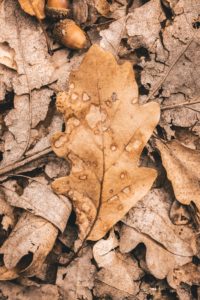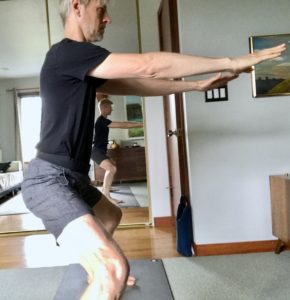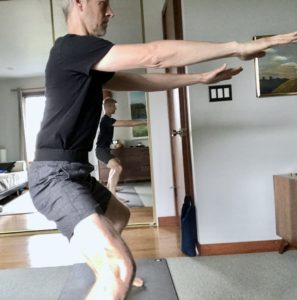
Northern California is for the most part a pretty dry climate, but our fall season can be brutally so. By October we typically have not had any rain for several months and the heat of summer has dried up much of the moisture in the environment. When you add in the effects of our “Indian Summer” with it’s hot temperatures, dry winds and exceedingly low humidity you have a formula for serious vata derangement.
Even as I write this I can feel how much dryer my sinuses are compared to last week when we had that welcome, but unusually high humidity and tropical rain. I can feel the dryness right into the back of my throat, and I can’t seem to put enough lotion on my hands. My experience tells me that these are mild but significant early signs that excess vata is starting to weaken my tissue a little, and if I’m not careful I may succumb to a cold or begin having digestive issues.
Vata or vata dosta is a fundamental physical and psychological energy that helps to move anything that needs moving. Vata is responsible for the movement of our food through the digestive track, for moving the nourishment we receive from our food into and through our bloodstream to our tissues, for moving nerve impulses from our brains through our nervous system and into our muscles and skin and for moving our thoughts so as to enable thinking and conscious action. Vata dosha is light, dry, cool and lacking in it’s own source of stability.
When vata is elevated it acts like a dry wind, weakening tissues and making them more vulnerable to degradation and possible infection. Inappropriate diet or lifestyle choices or external factors such as the weather or season can disturb vata in us and this may begin to negatively affect our health. The effects of elevated vata dosa are subtle at first. Perhaps I’m having more gas than usual, or I’m a bit constipated. I might notice my skin is a bit dryer than usual or I feel a bit agitated mentally and am having trouble relaxing fully or sleeping restfully. Whatever the signs, it’s when these signs first appear that we have a chance to make choices that will offset this excess vata and prevent it from having a more significant impact on our health.
One of my favorite concepts from ayurveda is dinacharya or “the daily routine.” Outlined in the ancient ayurvedic texts, dinacharya is a way for each of us to begin each day in perfect balance with the natural world. Most of the elements prescribed in this daily routine are simple, practical and obvious. They include waking up early, washing our face, drinking water, using the toilet, brushing our teeth, bathing, dressing and exercising. Some activities prescribed in dinacharya are less obvious but no less practical, such as acknowledging the new day, however we may choose to do this.
One daily routine outlined in the classical texts that is not commonly practiced in the western world is the application of oil to the head and body. I call this self oil massage or self abhyanga. Self abhyanga is not complicated. It simply means covering the body from head to toe with a significant amount of oil, ideally one that is suited to our individual constitution. After the oil is applied, preferably in a warm environment, it should be left on for 10-15 minutes, if possible, to allow time for it to absorb through the skin and into other tissues in the body. After this time it should be cleaned off the body during a warm shower or bath.
Oil is frequently used in ayurveda because of the way in which it penetrates into tissues. If the oil has herbs cooked into it, then the oil acts as a carrying agent to deliver the herbs and their properties to specific tissues. More generally oil is used to add liquidity and stability to tissue that may be in need of it. One application of the use of oil that I find particularly helpful is nasya or the placing of oil into the nose. Nasya helps to keep sinus tissues moist, healthy and well functioning and when certain herbs are cooked into the oil the practice can also improve the voice, vision and enhance mental clarity. Placing oil in the nose is also one of the daily routines outlined in the classical ayurvedic texts.
Application of oil is also a simple and effective way of balancing vata dosa. The heavy, moist qualities of warm oil can help to balance the dry, light and cool qualities of vata. Therefore I feel that it is the dinacharya practices that involve the use of oil and which I’ve outlined above that can be particularly useful for us Californians during the fall season.
Here are some more details on how to do self abhyanga and self nasya. Since everyone’s constitution is different, contact me or another qualified ayurvedic practitioner for choosing the best oils for you.
Self Abhyanga
Fill a small plastic bottle such as a travel bottle for shampoo with a food grade oil appropriate for your constitution. If you’re not sure which oil to choose, contact me for help.
Boil some water to warm the oil. Meanwhile, place some old towels (that you don’t mind getting oily) on the floor of your bathroom. Warm the room up so that you not only won’t get cold being in there for 15-20 minutes, but may even have a chance to sweat a little.
Place your plastic bottle of oil into a large coffee mug or similar. When the water is at or near a boil, fill the mug most of the way up or until you’ve covered enough of the bottle to warm the oil well. Take your filled cup and warm oil into the bathroom and place it somewhere convenient.
Begin to apply the warm oil, starting at the crown of your head and working downward. Make sure you use enough oil on each part of the body that the skin there cannot absorb all of the oil you apply. If you have time, rub the oil in using longitudinal strokes on your bones and circular strokes on your joints. Don’t worry too much about getting this right.
When the body is completely covered with oil, leave it on for another 10-15 minutes. You might enjoy doing some yoga postures or other simple exercise, pranayama or breathing exercises or sitting for meditation. When you’re ready or running out of time, take a warm bath or shower and clean off all of the oil. You will likely need to shampoo your hair twice to get all of the oil out.
Self abhyanga can be thought of as an act of self love. The experience should be nurturing and not feel rushed or in any way an imposition. If you’re stressed and/or don’t have time to approach it in this way, leave it until you do.
Contraindications for self abhyana include: skin rash, menstruation, cold and flu
Self Nasya – applying oil to the nose
There are various medicated nasya oils in the marketplace. Typically these have nervine sedative and/or nervine tonic herbs cooked into them. The one that we sell at Alignment Lab and that we recommend is produced by Banyan Botanicals. If you are unsure of which medicated oil to use you can contact me for help. If you feel uncomfortable with using medicated oils you can also use plain sesame oil.
Self nasya works best if you’re lying down and have time to let the oil penetrate deeper into the sinus passages. Warm the oil to body temperature or slightly higher but NOT until it’s hot. Lie down on your back and place several drops of the warm nasya oil in each nostril as outlined in the product instructions. If you’re using plain sesame oil use 8-10 drops.
Remain in a reclining position for 1-5 minutes and relax, giving the oil a chance to penetrate deep into the sinus passages. If you’re using a medicated oil and wish to facilitate the nervine effects of the herbs in the oil, stay 5 or more minutes and give the oil a chance to penetrate even deeper.
*The nose is considered a direct pathway to the brain, and this can be an effective way of delivering the herbs and their properties to it.
For the quickie version, place some warm oil into the palm of your hand. This can be done, for example, during your self abhyanga. Dunk your pinkie finger into the oil and rub it gently into your nostrils. Repeat this 2-3 times for each nostril while “sniffing” the oil with moderate force to get it to move higher up into your sinus passages. Massage the inside of the sinuses to help the oil penetrate in.
*This quickie method can be helpful for keeping the sinus passages moist and enhancing their ability to resist environmental irritants.
The dinacharya are a wonderful way of making health and wellness a part of each and every day. Even if you don’t have time to do every one of the activities prescribed, just having these routines as a touchstone will be a powerful and supportive resource for you. I have learned a lot and received many benefits from practicing these daily routines and I’m confident you will too!



